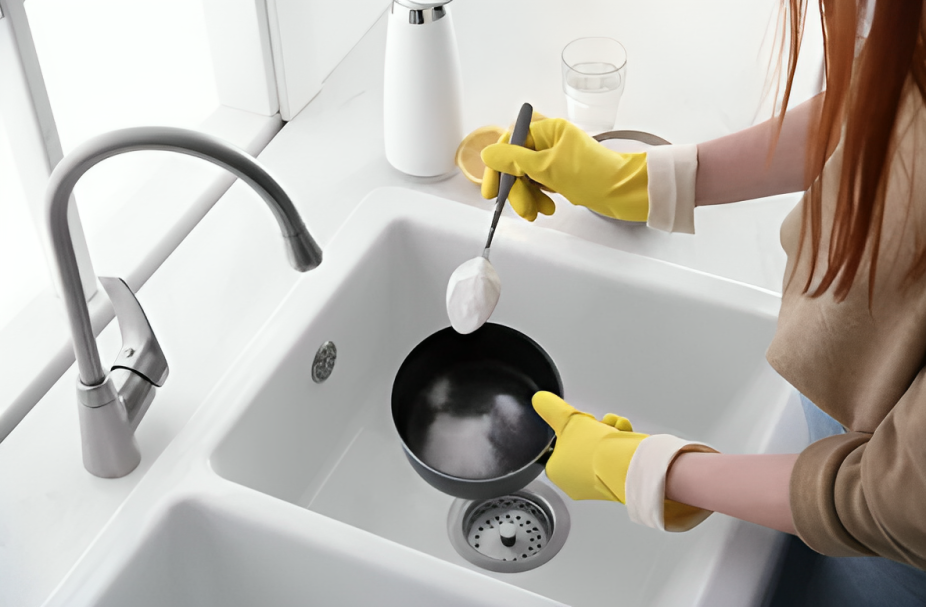
Best way to clean kitchen drain: A kitchen sink is the heart of any kitchen, facilitating food preparation, dishwashing, and general cleaning. However, a clogged or dirty kitchen sink drain can quickly turn this essential area into a hassle. To ensure the smooth functioning of your kitchen and maintain a clean and hygienic environment, it’s crucial to understand the best ways to clean and maintain your kitchen sink drain. This essay delves into a comprehensive guide on how to effectively clean your kitchen sink drain, prevent clogs, and promote a healthy kitchen environment.
What Causes Drain Clogs?
Before we delve into cleaning methods, it’s essential to identify the common culprits behind drain clogs. Kitchen sink drains are often prone to clogs due to the accumulation of various substances, including food particles, grease, soap scum, and debris. Over time, these materials can build up within the pipes, leading to slow drainage or complete blockages.
1.Regular Maintenance:
Key to a Healthy Kitchen Drain
Prevention is better than cure, and this holds true for kitchen sink drains as well. Implementing a few simple maintenance practices can go a long way in preventing clogs and maintaining a clean drain.
1-Use a Sink Strainer: Invest in a high-quality sink strainer to catch food particles and debris before they enter the drain. Empty the strainer after each use and clean it regularly.
2-Hot Water Rinse: Once a week, pour a pot of boiling water down the drain. This helps in melting grease and flushing away any accumulated residue.
3-Baking Soda and Vinegar: Monthly, pour half a cup of baking soda followed by half a cup of vinegar down the drain. Let it fizz and work for about 15 minutes, then flush with hot water. This helps break down buildup and eliminate odors.
Regular Cleaning: Wipe down the sink stopper, faucet, and drain opening regularly to prevent soap scum and grime buildup. A simple solution of dish soap and warm water works wonders.
2.Deep Cleaning Techniques
If your kitchen sink drain is already showing signs of slow drainage or foul odors, a deep cleaning is necessary. Here are some effective techniques to consider:
1-Mechanical Snaking: A drain snake, available at hardware stores, can help dislodge stubborn clogs. Insert the snake into the drain and twist it to break up and remove the clog.
2-Boiling Water and Salt: Pour a pot of boiling water mixed with half a cup of table salt down the drain. This method helps dissolve grease and small clogs.
3-Enzyme Cleaners: Enzymatic drain cleaners are effective in breaking down organic matter. Follow the manufacturer’s instructions for proper usage.
4-Hydrogen Peroxide and Baking Soda: Create a mixture of equal parts hydrogen peroxide and baking soda. Pour it down the drain and let it sit for an hour before rinsing with hot water. This method helps break down tough clogs.
Conclusion
A clean and well-maintained kitchen sink drain is essential for a functional and hygienic kitchen. By adopting regular maintenance practices and employing deep cleaning techniques when necessary, you can prevent clogs, eliminate foul odors, and extend the lifespan of your plumbing system. Remember that patience and consistency are key when dealing with drain cleaning, and a proactive approach will save you both time and money in the long run.
Q1: How often should I clean my kitchen sink drain?
A1: Regular maintenance is crucial to prevent clogs and maintain a clean drain. It’s recommended to clean the drain strainer after each use and perform a more thorough cleaning, such as using baking soda and vinegar, on a monthly basis. Additionally, a pot of boiling water can be poured down the drain weekly to help prevent buildup.
Q2: What should I do if my kitchen sink is already clogged?
A2: If your kitchen sink is clogged, start with a plunger to try and dislodge the clog. If that doesn’t work, you can use a drain snake to physically break up the clog. Another option is using a mixture of baking soda and vinegar to dissolve the clog, followed by flushing with hot water. For stubborn clogs, consider enzyme cleaners or hydrogen peroxide and baking soda.
Q3: Can I pour grease down the kitchen sink?
A3: No, pouring grease down the kitchen sink is a major contributor to drain clogs. Grease solidifies as it cools, sticking to the pipes and trapping food particles. It’s best to pour grease into a disposable container and throw it in the trash. Wipe greasy dishes with a paper towel before washing to minimize the amount of grease entering the drain.
Q4: How do I clean the sink strainer effectively?
A4: Cleaning the sink strainer is simple and important. After each use, remove the strainer and empty the collected food particles into the trash. Rinse the strainer under hot water to remove any remaining debris. For a more thorough clean, soak the strainer in a mixture of warm water and dish soap, then scrub it with a brush before rinsing.
Q5: Are chemical drain cleaners safe to use?
A5: While chemical drain cleaners can be effective in breaking down clogs, they can also be harsh on pipes and potentially harmful to the environment. Enzyme-based cleaners are generally considered safer as they use natural processes to break down organic matter. However, use any drain cleaner sparingly and follow the manufacturer’s instructions carefully.
Q6: How can I prevent foul odors coming from the kitchen sink drain?
A6: Foul odors are often caused by trapped food particles and residue. Regularly clean the sink stopper, drain opening, and surrounding areas with a solution of warm water and dish soap. Also, consider using a mixture of baking soda and vinegar down the drain to break down odor-causing buildup.
Q7: Are there any specific practices to avoid in order to prevent drain clogs?
A7: Yes, there are several practices to avoid. Never pour cooking oil or grease down the drain. Avoid putting large food scraps, coffee grounds, and fibrous materials (like onion peels) into the disposal. Also, use a sink strainer to catch debris, and avoid excessive use of chemical drain cleaners as they can damage pipes.
Q8: What if I’ve tried multiple methods and my drain is still clogged?
A8: If you’ve tried multiple methods and the clog persists, it might be time to seek professional help. A plumber has the tools and expertise to diagnose and address more serious clogs and plumbing issues. It’s important not to use excessive force or harsh chemicals that could damage your pipes further.
Q9: Can I use the same cleaning methods for both stainless steel and porcelain sinks?
A9: Yes, the cleaning methods mentioned in the essay are generally suitable for both stainless steel and porcelain sinks. However, be cautious with abrasive cleaners or scrubbing pads, as they can scratch or damage the sink’s surface, particularly in the case of porcelain sinks.
Q10: Is it necessary to clean the sink drain if I have a garbage disposal?
A10: Yes, even if you have a garbage disposal, it’s important to maintain a clean sink drain. While a disposal can handle some food scraps, large amounts of debris can still lead to clogs. Additionally, cleaning the drain prevents foul odors from developing in the disposal and pipes. Regular maintenance benefits both the disposal unit and the drain pipes.







